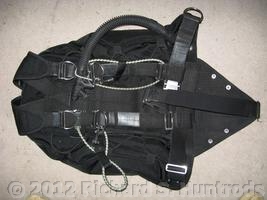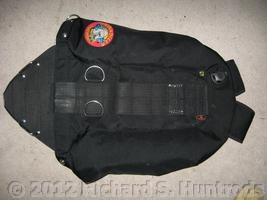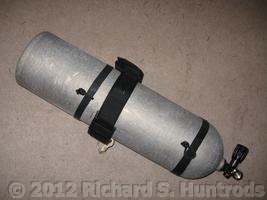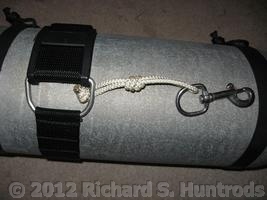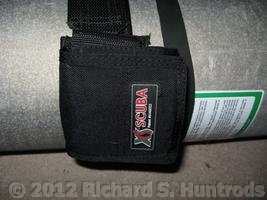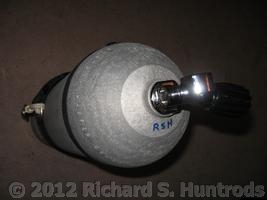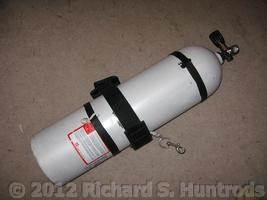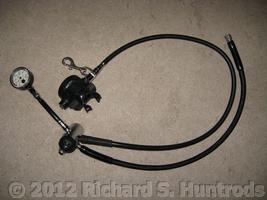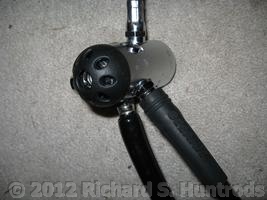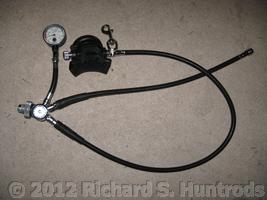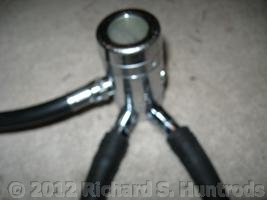Recently the concept of sidemount diving has become a topic of interest on various forums and diving discussions. Sidemount has been popular in cave diving for some time now, but more recently it has seen an upswing in popularity for non-cave divers. My own journey with sidemount began in July 2008 when I became interested enough to purhase an Armadillo rebreather "butt mount" kit. This kit provides bungees and a tail piece that attaches to the rebreather backplate, allowing you to sidemount your rebreather bailout tanks. From almost the first dive with this system I was sold on the benefits of sidemount and have been diving sidemount rebreather bailout ever since.
Some of the main benefits of sidemount include tanks being positioned up along the body from the underarms to just past the hips, moving the tanks out of the slipsream for more streamlined diving. Also, the tanks can be easier to attach by just clipping the butt clip then looping the bungees over the tank valves. Removal is just as easy. Carrying more than two tanks tends to mess up the whole streamlining effect, so the benefits are much less when you must carry more than two tanks. That said, I don't do dives at this time that require more than two bailout tanks.
Enjoying my sidemount rebreather bailout, as I started teaching open circuit SCUBA my thoughts turned to the idea of diving open circuit sidemount.
In March 2010 I purchased a used Armadillo sidemount full harness which consists of an integrated low profile wing, harness, butt plate and bungees. There is no rigid backplate with this system. Rather, the harness and wing wrap around the diver giving a very streamlined profile in the water. Adding tanks in the sidemount position continues the streamlined profile. Althought I purcased the Armadillo in 2010, it hung unused in my dive room for two years, until March 2012.
I decided to take the plunge and try out my Armadillo the week of March 18, 2012. After ensuring the Armadillo fit well and was adjusted properly (on land) I went to work on the other parts of the rig - tanks, regulators and weighting. Tanks were easy. I already had one 80cf tank rigged for sidemount and had been diving it as my rebreather bailout for some time. I had a second 80cf tank that I was using for tradional SCUBA diving, and had purchased the components to rig it for sidemount some time ago, so I quickly had two sidemount 80cf tanks. The regulators were a bit more work, but not much. I had two regulators for my bailout, but these had only a short small pressure guage and second stage. To work for open circuit sidemount, both would require a low pressure inflator whip, one for the Armadillo wing and one for my drysuit. These were quickly added, and I was ready for a test dive.
Weighting was going to be a challenge. Diving open circuit for teaching, I carry 20lbs in a DUI weight harness and two 4lb weights attached to the lower tank band (each in a little weight pouch). That's 28lbs, but you must count the stainless backplate as well (6lbs) for a total of 34lbs. I decided to use the same DUI harness, but added a couple of 2lb weights to the front pockets for a total of 24lbs in the harness. I added the same type of small weight pouch to the sidemount tank bands, and put 4lbs in each tank pouch for a rigged total of 32lbs. This was 2lbs lighter than my teaching rig, but I decided to see how it would work in open water and make changes on the test dive.
March 21 I headed to Elliot Park, which is close, sheltered and has a nice entry and gradual slope to the bottom. I kitted up with Linda looking on. I decided to attach the tanks and LP whips at the truck and then walked down to the water with tanks attached. That was one long walk, and I doubt I'll be doing that again! Once at the ocean I entered, donned fins and mask, and headed out. Everything checked out fine so I submerged in 5 fsw. I found I was a bit light, but was able to stay down without too much difficulty in 5-6fsw. Once I got to 8fsw I had no problems staying down. I headed out towards the wall and eventually reached 35fsw before turning around to come back in. Total dive time was 20 minutes, and it that time I had ample opportunity to see how the rig trimmed out and check the buoyancy. Sticking with our OW teaching practice, I used only suit inflation to manage buoyancy and it was more than sufficient. Once back at shore I removed the tanks laying on the surface but left the LP inflators attached until I had fins off and was standing in the shallows. Overall things worked out very well, with a few minor gear issues, mostly relating to the regulator hose placement. It looks like sidemount will be my preferred rigging both open circuit and rebreather bailout from now on.
Some aspects of sidemount gear rigging are identical whether you dive sidemount rebreather or open circuit. This includes tank band placement and most of the regulator setup. There are some differences as well, such as weight pouches for the tanks and low pressure inflators for the regulators.
The tank band placement is critical for proper trim of both the tanks and the diver underwater. In normal stage rigging, a clip is placed on the neck of the tank and another near the bottom of the tank. The neck clip attaches to the harness chest d-ring and the lower clip attaches to the hip d-ring. For sidemount, there is only one band and clip which attaches to the butt plate. This clip should be very close to the center of balance for the tank, or just below the halfway mark on the tank. I use standard tank cam-bands rather than metal hose clamps because this allows me to remove or adjust the clip easily, which allows me to use the tanks as 'normal' SCUBA tanks if necessary. For OC sidemount, a small weight pouch was added to the cam band. The clip is attached to a loop of rope knotted at one end in two places (see photos). The rope slides under the cam band fastener and the knots lock it in place once the cam bands are tightened. You should be able to lift the tank by the clip without anthing shifting. The clip is located directly opposite the tank valve so that when attached, the bungees will loop aroung the valve and hold the tank securely. Again, refer to the pictures below.
Some sidemount divers purchase special right and left tank valves so they are the same on both sides, but I did not have that luxury at this time. After today's successful dive I doubt I'll go that route either.
The second key component of the sidemount tank is the regulator. The most optimum sidemount configuration is to dive with two tanks, one on each side. This provides balance to the rig as well as gas redundancy to the diver. Keeping reduncancy in mind, each tank should be fitted with a low pressure inflator rather than putting two on one tank. That way even if gas is lost from one tank, the other will supply the diver with air and buoyancy gas.
The Armadillo is similar to most wings in that the low pressure inflator is on the diver's left side. This means the left tank will be supplying the inflation gas via it's low pressure inflator. I did not have any custom short LP whips, so simply used the standard whip that I had. The right side tank supplies drysuit gas. Again, all I had was a standard LP whip.
The only thing I added to the second stages was a small clip at the end of the hose so that I could clip whichever regulator I was not breathing from to my chest d-ring so that it was available at all times. When diving sidemount rebreather bailout, I normally have the second stage and hose stowed in rubber bands on the side of the tank, easily reached and deployed if needed. However, in open circut as these are now my active regulators I wanted them closer.
Some sidemount divers have special fittings on the right and left second stages to allow them swivel for better orientation to the diver's mouth, and some use longer 'donor' hoses on one of the regulators. All I had was normal length hoses on my regulators, so that is what I used. In the end I found that using standard hoses and regs was not a big deal underwater, so I doubt I'll change that anytime soon.
Because my regulators were already in use as rebreather sidemount bailout, they already had small pressure guages on short (8 inch) hoses. Rather than having them face back toward the tank as in stage rigging, I faced them forward so I can grab them and look at them when the tanks are in position when sidemounted.
What I am not thrilled about after rigging the regulators and doing my test dive is the position of the two hoses coming off the regulator first stage. On the Dacor Fury, the position OK. Both hoses face towards the tank (rearward) and were unobtrusive. On Apex swivel first stage however, one of the two hoses projects 'up' at about 30 degrees, causing small difficulty attaching the bungee and generally just sticking out in a way I'm not pleased with. I will have to see what I can do about that.
I did a longer 'real' dive at Madrona today using the sidemount configuration mentioned above with the following changes:
- Switched to a longer (5ft) hose on the left regulator
- Swapped LP hoses on the regs for better fit to the LP inflator (longer hose on right) and drysuit (shorter hose on left).
- Added 2x2lb to the DUI weight harness for a total of 28lb.
- Decided to carry tanks to the water, attach LP inflators on shore, then wade in, don fins and mask, then clip tanks.
- Decided to unclip tanks in shallows at dive's end, then stand and unclip LP inflators.
- Changed from clip to bungee on the left (shorter) regulator.
Overall the changes did improve things from the Elliot Park dive, but there were still some issues that made the dive less than a total fun experience. The long hose does NOT stow nicely in my opinion. I know a number of divers that have a long hose on their stage reg, but I simply don't like how it stows. It's also too long to loop nicely around the neck. I ended up having to wrap it twice which is just ... wrong. Otherwise the changes worked out very well, with the exception of 'getting out'.
There is no doubt about it, getting out of the water on a shore dive with sidemount is a huge pain. Unclipping is fine. Taking off fins is fine. Standing is fine, until you find you are juggling trying to hold two tanks, two fins, and then trying to unclip the LP inflators. With any wave action at all, it's not pleasant. The risk of dropping fins or a tank is quite high, and I did lose grip on one tank. This causes yanking of the LP inflator and a general 'this is not fun' experience.
Clipping and unclipping LP hoses underwater would be much easier, but I really do not think clipping LP connections underwater in salt water is a really bright idea. I've asked some gear makers whose opinion I value and they agree that plugging QC connectors underwater in salt water is going to be hard on gear. Unclipping might be OK, but I'm overall not very impressed with this part of the dive.
The other thing that must be considered is the pros and cons. Yes, cleaning up OC gear is about twice as fast as CC gear - maybe even 3 times faster. But that's about the only benefit. With CC I carry much less weight on the harness (10lbs vs 28), and getting in and out of the water is a breeze - even with sidemount bailout (unclip, stand and walk out). Dealing with two tanks seems to more than double the 'not fun', and plugging and unplugging LP connectors from the tanks is something that I still need to resolve. Frankly, I find diving my rebreather much, MUCH more relaxing and fun at this point. All this for nowhere near as much gas benefit. 2x80cf tanks will give you at most 2x50min diving under ideal conditions and not going very deep. By comparison, the rebreather easily gives me as much time (and more if I can stand the cold) and is depth independent.
Finally, there's the changes in buoyancy during the dive. A luxfer 80cf tank weighs about 35lbs (37.5 full). Buoyance full is -1.9lbs and empty is +4lbs for a buoyancy shift of almost 6lbs. Weighting should ideally be calculated with nearly empty tanks, which means carrying a minimum of 6-8lbs more than one needs at the start of the dive. Today (March 25) I had 4lbs on each tank, essentially making them neutral at the end of the dive, and 28lbs on my DUI weight harness. Using 28lb harness weight is NOT enought to keep me down by itself - I need the weight of the tanks as well. This means I really should be carrying at least 6 more pounds somewhere - clipped to the Armadillo, on the tank, or in the weight harness - except the harness is full now getting to 28lbs. All in all it's a lot of weight for the sidemount experience.
The final thing I noticed about open circuit vs. rebreather was my deco obligation. On rebreather I use a 1.3 PO2 setpoint and can dive Madrona from one end of the large wall to the other and back almost without going into deco. I can avoid deco if I come up from 90fsw to 75fsw on the return leg. On open circuit today my NDL was 1 minute near the end of the wall, and this was a lower tide day so max depth was almost 10fsw shallower than other dives I've done. The NDL didn't increase until I was above 50fsw as we headed in. This was using the exact same computer (Shearwater Predator) and totally the same settings - the only difference was CC=1.3PO2 vs. OC=Air. I use air diluent on rebreather, so the only difference is the difference created by constant PO2 vs. open circuit. Again, another entry in the 'con' column for sidemount for me.
